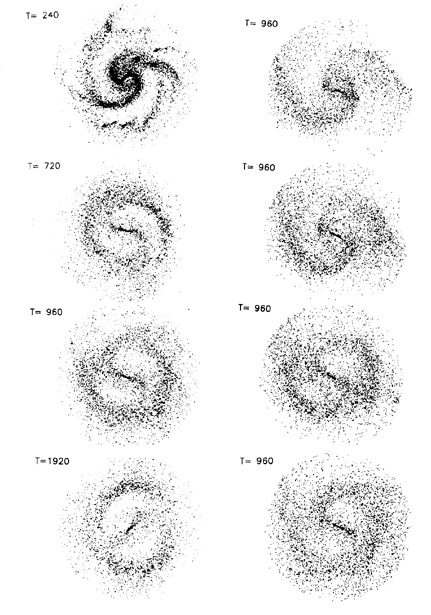
|



17. TIDAL INTERACTIONS AND RINGS
The influence of environment on the presence of rings was first studied by Madore (1980) who noted that galaxies with inner rings had significantly less close companions than average, about twice less.
Elmegreen et al. (1992b) studied in detail the influence of environment on outer rings and pseudo-rings in 153 bright spiral galaxies. The objects were selected from the catalog of bright ringed galaxies in de Vaucouleurs & Buta (1980a): 45 have semidetached outer ring (R) structures and 108 have outer pseudo-ring (R') structures. The environment of the objects was determined from the following catalogs: field (Turner 1976), pseudo-field (those galaxies that are relatively isolated but are suspected of being in groups, listed with an asterisk in the table by Turner 1976), groups (Geller & Huchra 1983; Turner & Gott 1976), and binaries (Peterson 1979 and Turner 1976).
A first interesting remark is that pure outer rings are much more frequent in early-type galaxies, such as SB0 and SB0/a (see also section 9.1 and Figure 24). De Vaucouleurs and Buta's survey is heavily weighted toward these types, which comprise 24% of all the catalogued outer ring (R) galaxies, as compared to 7.9% for galaxies in general. It was found that a high fraction of these early barred galaxies in the field has an outer ring, 67 ± 27%, while almost none of them has an outer ring in groups or binary systems.
The high fraction of extremely early barred galaxies with outer rings in the field may be interpreted in terms of the long formation time of detached outer rings with respect to the dynamical time. Because of their higher total mass, and higher average density, the internal dynamical time-scale of early-type galaxies is shorter, and they are dynamically more evolved: outer rings had more time to form, for a given bar strength, than in later-type galaxies. The low fraction of these early-type galaxies with detached outer rings in groups and binary systems implies that tidal interactions destroy the rings or prevent their formation.
The fraction of SB0 and SB0/a galaxies with outer pseudo-rings displays the opposite behavior as a function of environmental density. Now the fraction is zero in the field and increases with density, up to 15%. This result suggests that companions do not always destroy completely outer rings, but that some companions convert outer rings into outer pseudo-rings. There could still be some tidal destruction of rings (or inhibition of ring formation) too, because the fraction of SB0 and SB0/a galaxies with any type of outer ring (R or R') decreases with companion density, varying from 67% to an average of 15%. These numbers are consistent with a conversion of about 20% of the outer pure rings in binary SB0 and SB0/a galaxies into outer pseudo-rings, and a destruction of the other 80%. An alternative interpretation could be that bars in binary galaxies are younger than bars in the field because the companions made the bars (i.e., Noguchi 1987; Combes 1988; Elmegreen et al. 1990). In this case, the younger bars have not had time to make pure outer rings but only outer pseudo-rings.
Another interesting result concerns the nonbarred galaxies. First the fraction of true outer rings in nonbarred galaxies is insignificant, which confirms the much larger efficiency of the bar in the ring formation. Secondly it is found that the fraction of late-type nonbarred galaxies with outer pseudo-rings decreases with environmental density from 25% to 5% from the field to binary systems. This suggests that companions either destroy or prevent the formation of pseudo-rings in nonbarred galaxies.
The decrease in pseudo-ring fraction with increasing environmental density among SA galaxies implies that the pseudo-rings are not made by tidal perturbations, but are made internally and then destroyed or altered by tidal perturbations. This helps to discriminate between the two possibilities opened by the results found on early-type galaxies, where the fraction of pseudo-rings increases with environmental density: these pseudo-rings must come from destroyed rings.
Computer simulations confirm the extreme fragility of outer rings with respect to tidal interactions (see Figure 86). Rings in barred galaxies are easily destroyed or converted into pseudo-rings by transient prograde interactions, and the same rings are converted into pseudo-rings by transient retrograde interactions. In a binary galaxy with a strong bar, where the ring formation time-scale can be about the same as the companion orbital period, a complete outer ring may have no time to form. Spiral structure will be generated at each encounter, and the incipient ring will only be able to form a pseudo-ring under the action of the unperturbed stellar bar. The companion may also change periodically the pattern speed of the bar (Gerin et al. 1990, Sundin et al. 1993), which prevents the formation of a pure ring.

|